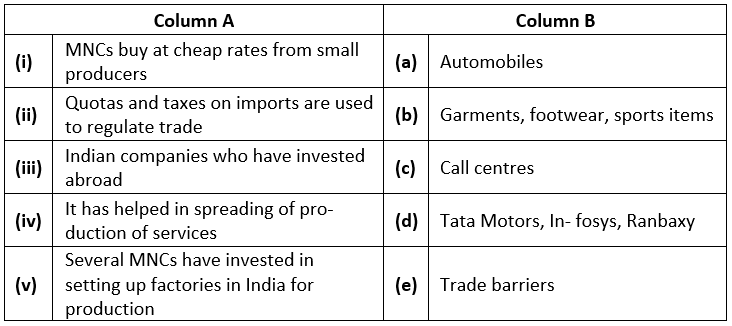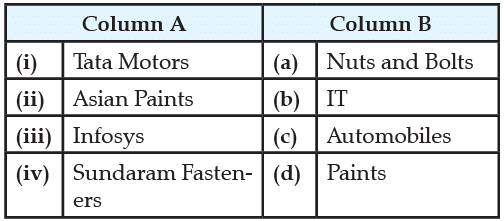Economics Mock Test- 2 - Class 10 MCQ
30 Questions MCQ Test - Economics Mock Test- 2
The agencies which look into the complaints of the consumers are popularly called :
An Act which ensures citizens of India to know about the functioning of the government departments :
When economic activities in a country are influenced by economic activities in other countries, it is called
A company that operates in more than one country is called a
The minimum area of the land required to sustain the life of one person completely is called his
Which one of the following Indian industries has been hit hard by globalisation?
The economy is classified into public and private sectors on the basis of :
India according to the World Bank classification falls in the category of
What is the significance of the Gini coefficient in assessing a country's economic landscape?
Why is per capita income considered an important indicator for comparing the economic well-being of different countries?
Direction: Mark the option which is most suitable:
Assertion : The Reserve Bank of India supervises the functioning of formal sources of loans.
Reason : The RBI sees that the banks give loans not just to profit-making businesses and traders but also to small cultivators, small scale industries, to small borrowers etc.
Direction: Mark the option which is most suitable:
Assertion : The terms of deposit are same for all credit arrangements.
Reason : Credit arrangements are very complex process so to remove the complexities same terms of deposits are used.
Direction: Mark the option which is most suitable:
Assertion : Credit would be useful or not depending on the risk involved in a situation.
Reason : The chance of benefiting from credit is highest in the agriculture sector.
Government owns most of the assets and provides all the services:
The overall welfare of people in any society is determined by
Read the extract given below and answer the questions that follows:
Globalization expands and accelerates the movement and exchange of ideas and commodities over vast distances. Globalisation has created more competitive environment in India. In the past two to three decades, more and more MNCs have been looking for locations around the world which would be cheap for their production. Foreign investment by MNCs in these countries has been rising. At the same time, foreign trade between countries has been rising rapidly. A large part of the foreign trade is also controlled by MNCs. The result of greater foreign investment and greater foreign trade has been greater integration of production and markets across countries. Globalisation is this process of rapid integration or interconnection between countries. MNCs are playing a major role in the globalisation process. More and more goods and services, investments and technology are moving between countries. Besides the movements of goods, services, investments and technology, there is one more way in which the countries can be connected. This is through the movement of people between countries. People usually move from one country to another in search of better income, better jobs or better education. Rapid improvement in technology has been one major factor that has stimulated the Globalisation process. Even more remarkable have been the developments in information and communication technology. Globalisation and greater competition among producers - both local and foreign producers - has been of advantage to consumers, particularly the well-off sections in the urban areas. There is greater choice before these consumers who now enjoy improved quality and lower prices for several products. As a result, these people today, enjoy much higher standards of living than was possible earlier. Globalisation has also created new opportunities for companies providing services, particularly those involving IT.
Answer the following MCQs by choosing the most appropriate option
Q. Globalisation has posed major challenges for:
Read the extract given below and answer the questions that follows:
Globalization expands and accelerates the movement and exchange of ideas and commodities over vast distances. Globalisation has created more competitive environment in India. In the past two to three decades, more and more MNCs have been looking for locations around the world which would be cheap for their production. Foreign investment by MNCs in these countries has been rising. At the same time, foreign trade between countries has been rising rapidly. A large part of the foreign trade is also controlled by MNCs. The result of greater foreign investment and greater foreign trade has been greater integration of production and markets across countries. Globalisation is this process of rapid integration or interconnection between countries. MNCs are playing a major role in the globalisation process. More and more goods and services, investments and technology are moving between countries. Besides the movements of goods, services, investments and technology, there is one more way in which the countries can be connected. This is through the movement of people between countries. People usually move from one country to another in search of better income, better jobs or better education. Rapid improvement in technology has been one major factor that has stimulated the Globalisation process. Even more remarkable have been the developments in information and communication technology. Globalisation and greater competition among producers - both local and foreign producers - has been of advantage to consumers, particularly the well-off sections in the urban areas. There is greater choice before these consumers who now enjoy improved quality and lower prices for several products. As a result, these people today, enjoy much higher standards of living than was possible earlier. Globalisation has also created new opportunities for companies providing services, particularly those involving IT.
Answer the following MCQs by choosing the most appropriate option
Q. Process of integration of different countries is called
Match the following items given in column A with those in column B:

Match the following items given in column A with those in column B:















